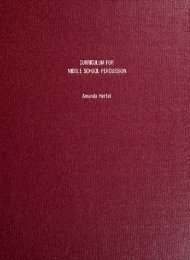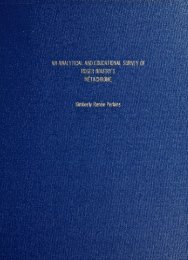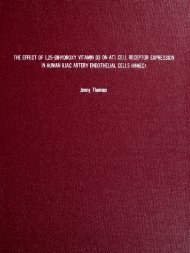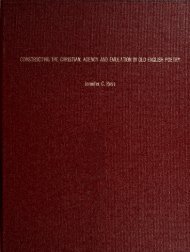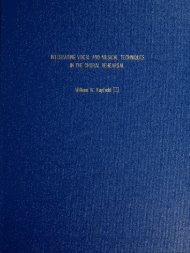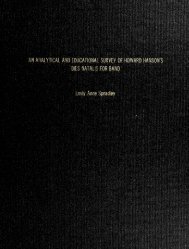Motionless as an Idol - Columbus State University
Motionless as an Idol - Columbus State University
Motionless as an Idol - Columbus State University
- No tags were found...
You also want an ePaper? Increase the reach of your titles
YUMPU automatically turns print PDFs into web optimized ePapers that Google loves.
Bullock 14appropriately, that voice h<strong>as</strong> strong m<strong>as</strong>culine overtones. An import<strong>an</strong>t distinctionbetween the texts <strong>an</strong>alyzed in this project relates to the narrating voice. In "A Rose forEmily/' the narrator is male <strong>an</strong>d speaks for the community <strong>as</strong> a whole, unlike the novelsin which different characters take turns narrating. This difference in voice also speaks tothe autonomy of the characters, allowing the speakers more authority th<strong>an</strong> those who aremerely spoken of.The community voice, society, sees Miss Emily through a lens of art, <strong>an</strong>d thatlens represents the cage in which Miss Emily is confined because art is not capable ofcreation; instead, art is completely subject to the will <strong>an</strong>d intention of its artist <strong>an</strong>daudience. Miss Emily's society views her <strong>as</strong> <strong>an</strong> artistic creation, not <strong>an</strong> artist or a creator,<strong>an</strong>d therefore, the community feels no qualms about imposing all of their history,traditions, beliefs, <strong>an</strong>d social conventions upon her without considering her desire, or lackthereof, to meet their expectations. Early in the story, the town clearly describes the wayin which they perceive Miss Emily: "Alive Miss Emily had been a tradition, a duty <strong>an</strong>d acare; a sort of hereditary obligation upon the town," (Faulkner 74). The townspeople seeher <strong>as</strong> a "tableau," <strong>an</strong> "idol," <strong>an</strong>d <strong>an</strong> "<strong>an</strong>ger in a stained gl<strong>as</strong>s church window (Faulkner76, 77). All of the art metaphors they create for Miss Emily fulfill that initial description,each relating directly to the sense of duty <strong>an</strong>d obligation.The clearest example of the townspeople's conceptualization of Miss Emily <strong>as</strong> artis the way in which they describe her with her father in the setting of the tableau. Atableau is commonly thought of <strong>as</strong> a picture, but it c<strong>an</strong> also be the posing of a picture,such <strong>as</strong> a portrait. The following describes what is imagined <strong>as</strong> a family portrait from theperspective of the townspeople:



